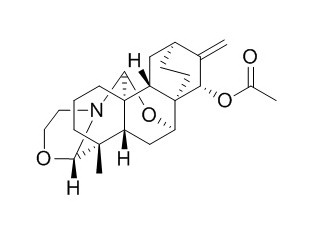Spiramine A
Standard reference
Inquire / Order:
manager@chemfaces.com
Technical Inquiries:
service@chemfaces.com
Tel:
+86-27-84237783
Fax:
+86-27-84254680
Address:
1 Building, No. 83, CheCheng Rd., Wuhan Economic and Technological Development Zone, Wuhan, Hubei 430056, PRC
Providing storage is as stated on the product vial and the vial is kept tightly sealed, the product can be stored for up to
24 months(2-8C).
Wherever possible, you should prepare and use solutions on the same day. However, if you need to make up stock solutions in advance, we recommend that you store the solution as aliquots in tightly sealed vials at -20C. Generally, these will be useable for up to two weeks. Before use, and prior to opening the vial we recommend that you allow your product to equilibrate to room temperature for at least 1 hour.
Need more advice on solubility, usage and handling? Please email to: service@chemfaces.com
The packaging of the product may have turned upside down during transportation, resulting in the natural compounds adhering to the neck or cap of the vial. take the vial out of its packaging and gently shake to let the compounds fall to the bottom of the vial. for liquid products, centrifuge at 200-500 RPM to gather the liquid at the bottom of the vial. try to avoid loss or contamination during handling.
Nutrients.2023, 15(12):2810.
Cell Metab.2020, S1550-4131(20)30002-4
Journal of Ginseng Research2019, 10.1016
J Microbiol Immunol Infect.2021, S1684-1182(21)00142-0.
Kor.J.Herbol.2024, 39(3):23-35
Int J Mol Sci.2020, 21(7):2530.
Br J Pharmacol.2016, 173(2):396-410
Biochem Biophys Res Commun.2020, 522(1):40-46
Molecules.2024, 29(22):5261.
Chinese Medicine2019, 14(1)
Related and Featured Products
J Nat Prod. 2009 Apr;72(4):645-9.
Approach to the biosynthesis of atisine-type diterpenoid alkaloids.[Pubmed:
19275222]
METHODS AND RESULTS:
To determine the biosynthesis pathway of the atisine-type diterpenoid alkaloids Spiramine A/B and C/D, feeding experiments in in vitro cultured plantlets and enzymatic transformations in cell-free extracts were performed in combination with LCMS and tandem MS analyses. L-[2-(13)C,(15)N]Serine was used in the feeding experiments and enzymatic transformations, and the diterpene spiraminol was identified as a biosynthetic precursor of Spiramine Alkaloids. The LCMS and tandem MS spectra of the extracts from these experiments indicated that L-[2-(13)C,(15)N]serine was incorporated into Spiramine A/B and C/D.
CONCLUSIONS:
The labeled reaction products show that l-serine is the one possible nitrogen source involved in the biosynthesis of atisine-type DAs.



